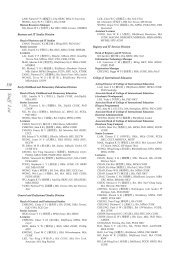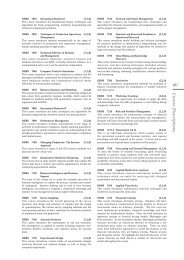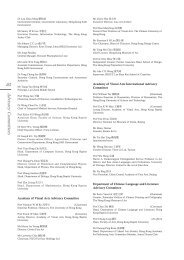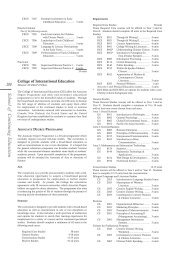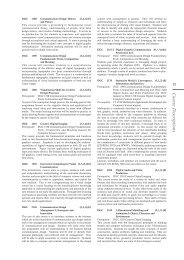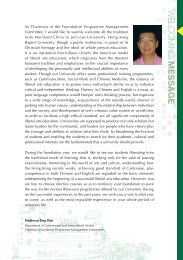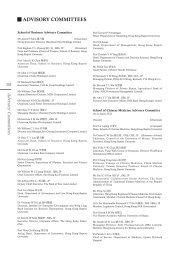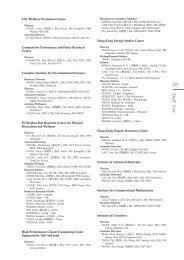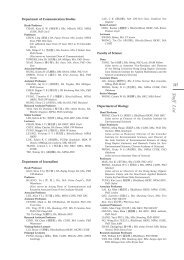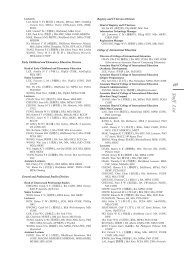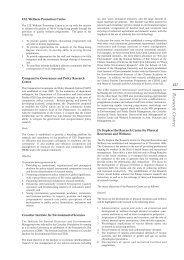376<strong>Course</strong> <strong>Descriptions</strong>GEOG 2006 Earth Systems: Shaping (3,2,1) (E)LandscapesThis course is complementary with GEOG 2016 Earth Systems:Atmosphere and Biosphere and introduces geomorphology andthe main facets that have contributed to the study of landforms.Emphases are placed on: plate tectonic theory, as a frameworkto explain the major relief features of eastern Asia; on commongeological materials and structures that control landscape in <strong>Hong</strong><strong>Kong</strong>; and on the processes of weathering, erosion and depositionthat produce contrasting landscapes.GEOG 2007 Introduction to Quantitative (3,2,1) (E)Methods in GeographyThis course provides an introduction into statistical analysis ofgeographic data. Through real-world examples from various topicareas of geography, students learn sampling methods, descriptiveand inferential statistical techniques for analysing geographicdata. Topics include hypothesis testing, spatial statistics, statisticalrelationships between variables, and how to generate, summarizeand present geographic data, etc. The course will assist studentsin developing a knowledge basis for understanding more advancedmethods of geographic analysis.GEOG 2015 Cartography (3,2,2) (E)Cartography is the art, science and technology of making maps.Maps are the communication media for geographers to expresstheir views about our world, in a similar way that language isfor literary authors. Understanding of map-making processesand mastering the skills of map-reading greatly enhance thepresentation of geographical information in graphic format.Moreover, this format can be an effective tool for data analysessuch as, for example, when examining the relationship betweentwo distributions using simple transparent overlays. Students canapply such a mapping ability to their natural or social sciencecourses or in their professional fields.GEOG 2016 Earth Systems: Atmosphere and (3,2,1) (E)BiosphereThis course seeks to provide understanding of the ecosystemessentials and the atmospheric processes governing weatherand climate. The first part is a comprehensive analysis of thecharacteristics of vegetation on the earth’s surface. Emphasis isplaced on their distribution, and their significance in human’s useof land. The second part introduces climatology. Emphases areplaced on energy flow and temperature, atmospheric moisture,atmospheric circulation, climate classification and climate change.GEOG 2017 Globalization of Economic (3,2,1) (E)ActivitiesThis is an introductory course on economic geography. Studentsare first introduced to the basic features of economic globalizationand their geographic ramifications. The course then describes insome detail the major forces and processes that underlie globalproduction shifts, identifying the main actors involved andoutlining the implications for the spatial organization of economicactivities at various geographic scales: world, nation and region.GEOG 2025 <strong>Hong</strong> <strong>Kong</strong> and the Pearl River (3,2,1) (E)Delta: A SurveyThis course provides a comprehensive and lively guide to thehistory, culture, geography and economic development of SouthChina. This objective is to be achieved by a series of wellorganizedlectures and tutorials. Field trips, both in <strong>Hong</strong> <strong>Kong</strong>and to the Pearl River Delta, which will provide an invaluableonsite experience to elaborate the types and magnitude of changein South China discussed in lectures, may be organized. It ishoped that this course will constitute an essential gateway to thosewishing to acquire a deeper understanding of this dynamic cornerof Asia.GEOG 2110 Regional Geography of China (3,3,0) (E)Regional geography is concerned with geographical synthesis witha specific “region” as its focus. The course is an introductory andfoundation course which aims to familiarize students with broadaspects of development in China, including its human, physical,cultural and economic activities and also their impact on theenvironment and landscape.GEOG 2140 Global Environmental Issues and (3,2,1) (E)SustainabilityThis course covers environmental problems in the atmosphere,hydrosphere, lithosphere and the biosphere. Sustainability is theover-arching theme of this concept-centred, solution-oriented, andscience-based course on contemporary environmental problems.Field and laboratory study form an integral part of the course.GEOG 2150 Population Geography (3,2,1)This course aims at familiarizing students with concepts andmethodologies to examine population problems and evaluatepopulation policies from a geographical perspective. Thecourse is concerned with conceptualizing and measuringpopulation structure and its dynamics. It explains the way inwhich populations are distributed through space and over time,together with various factors that generate changes. In particular,the evolving patterns of fertility, mortality and migration areexamined from both spatial and temporal perspectives.GEOG 2160 Energy Problems and the (3,3,0) (E)EnvironmentAn introduction to the causes and effects of the energy problemswhich have arisen since 1973. The major sources of commercialenergy—oil, coal and natural gas—are treated with respect totheir characteristics, exploration and development, major uses,world production pattern, pricing and trade. The special role ofelectricity, together with problems connected with nuclear power,is covered. Furthermore, the nature and the ramifications of the1973, 1980 and 2008 oil crises are discussed.GEOG 2180 Urban Geography (3,2,1) (E)An introduction to contemporary theories of urbanization, urbanhierarchy, and the internal structure of the city. Such theories arerelated to empirical studies in geography and discuss the complexrelationships between urban growth and social, economic,technological, and environmental changes in human society.Some field-study may be required.GEOG 2320 Geography of Pacific Asia (3,3,0) (E)This course introduces students to various aspects of thegeography of Pacific Asia. The major concerns include economicand social progress, political evolution, physical advantages andconstraints, resource bases, rural development, urbanization,industrialization and government policies in the economicdevelopment. In addition, economic and political relationsbetween countries in the region are discussed. Reference will alsobe made to the spatial aspects of contemporary issues in SoutheastAsia, the Pacific Island Region, Australia and New Zealand.GEOG 2600 Techniques in Physical Geography (3,2,1)This course introduces (1) the field and laboratory techniquesin geomorphology and biogeography, and (2) the use ofmeteorological instrument and ways to access and analyse weathermaps/images.GEOG 2800 Geography of Health and the (3,3,0)EnvironmentSince ancient times, people have worked, lived and multipliedunder a wide variety of environmental conditions. Accordingto Chinese medical theory, human health is affected by a lack ofequilibrium between body and its surrounding environment. Thisis especially the case where the ecology of the environment isabnormal. Consequently, geographic variability has long been animportant aspect of health studies in both Eastern and Westerncultures. This has been expressed in a variety of approachesranging from geographic pathology to medical ecology, as well asdisciplines such as geographical epidemiology, biometeorology,geomedicine, and so forth. This course aims to introduce
students to the concepts and techniques in the discipline ofmedical geography in general and to examine recent trends in thegeographic variation of health.GEOG 3005 Field Camp (0,*,*)Field camp will be held during the second semester of a student’sthird year and covers a seven- to nine-day period. Usually it isbased in China or Southeast Asia. A wide range of geographicalfield techniques are utilized in the collection of geographicinformation and for conducting field research into physical,cultural and developmental problems. While no grades or unitcredits are given for this camp, the student must complete theprogramme to the department’s satisfaction for graduation.GEOG 3006 Regional Geography of China (3,3,0)This is an introductory course on the geography of China.A regional approach is employed to provide students acomprehensive collection of topics over the physical setting,natural resources, population, urban and regional development,industrial and agricultural development, administrative systemand geopolitics. These topics span across the time period beforeand after the country launched its economic reform. This coursecovers not only topics on social, economic and environmentalissues, but also introduces a perspective to understand theseactivities and their changes.GEOG 3007 Energy Problems and the (3,3,0) (E)EnvironmentThis course introduces students to the causes and effects ofthe energy problems which have arisen since 1973. The majorsources of commercial energy—oil, coal and natural gas—aretreated with respect to their special characteristics, explorationand development, major uses, world production pattern, pricingand trade. The special role of electricity, together with problemsconnected with nuclear power, is covered. Furthermore, the natureand ramifications of the 1973, 1980 and recent oil crises arediscussed.GEOG 3015 Geography of Health and the (3,3,0)EnvironmentSince ancient times, people have worked, lived and multipliedunder a wide variety of environmental conditions. Accordingto Chinese medical theory, human health is affected by a lack ofequilibrium between body and its surrounding environment. Thisis especially the case where the ecology of the environment isabnormal. Consequently, geographic variability has long been animportant aspect of health studies in both Eastern and Westerncultures. This has been expressed in a variety of approachesranging from geographic pathology to medical ecology, as well asdisciplines such as geographical epidemiology, biometeorology,geomedicine, and so forth. The course provides an introductionto the concepts and techniques in the discipline of medicalgeography and to examine recent trends in the geographicvariation of health.GEOG 3016 Geography of Pacific Asia (3,3,0) (E)The Pacific Asia region covers vast areas of the Russian Far East,East and Southeast Asia, Australia, New Zealand, and manyPacific Island nations. It is very rich in natural resources, history,culture, economy, and political systems. Since the 1970s, theRegion has experienced rapid socioeconomic development. Withglobalization and the emergence of the Chinese economy, inparticular, Pacific Asia has become a powerful “engine” for theworld development.GEOG 3017 Global Environment Issues and (3,2,1) (E)SustainabilityThis course covers environmental problems in the atmosphere,hydrosphere, lithosphere and the biosphere. Sustainability is theover-arching theme of this concept-centred, solution-oriented, andscience-based course on contemporary environmental problems.Field and laboratory study form an integral part of the course.GEOG 3025 Population Geography (3,2,1)This course teaches students with concepts and methodologies toexamine population problems and evaluate population policiesfrom a geographical perspective. The course is concernedwith conceptualizing and measuring population structure andits dynamics. It explains the way in which populations aredistributed through space and over time, together with variousfactors that generate changes. In particular, the evolving patternsof fertility, mortality and migration are examined from bothspatial and temporal perspectives.GEOG 3026 Techniques in Physical Geography (3,2,1)This course introduces (1) the field and laboratory techniquesin geomorphology and biogeography, and (2) the use ofmeteorological instruments and ways to access and analyseweather maps/images.GEOG 3027 Urban Geography (3,2,1) (E)We live in an urbanizing world today. It is, thus, imperativeto have a basic understanding of this still growing urbanphenomenon. The perspective of urban geography emphasizes theproduction of spatial differences among cities of the world. Whatis the nature and scope of urban geography? When, where andwhy did cities arise? How has globalisation affected the growth ofcities recently? Why are cities in the Third World growing fasterthan those in the developed world? Are the socialist cities plannedwithout socio-economic problems? How do we understand urbansystems in any country? What are the major socio-economic andspatial features of cities? What are the differences among thedeveloped world, the Third World and the socialist world?GEOG 3130 Geographical Imaginations (3,2,1) (E)This course aims at introducing geography majors to the morephilosophical and methodological discussions in the field.Because what geographers do is complex, and the complexityis ever-changing, they tend to have excelled on different aspectsof the field and, conversely, ignored its more philosophical andmethodological underpinnings. This course is an attempt toredress this imbalance. It surveys the main trends in Westerngeographic thought over the last hundred years and investigatesin detail a few theories of the last thirty years, including thequantitative revolution, humanistic geography, radical geography,locality studies and post-modernism. A brief introduction to theChinese geographic thought is also provided as a complement. Itis hoped that after taking this course, Geography majors wouldbe able to tackle the philosophical and methodological themes incontemporary geographic thought and make sense of their ownidentity.GEOG 3580 Honours Project (3,*,*)Prerequisite: BSocSc (Hons) in China Studies Year III standingA required course the purposes of which are to provide actualresearch experience and an opportunity to undertake a syntheticalapproach. Students are expected, under the guidance of teachingstaff, to conduct a study on aspects of Chinese geography.Identification of a research problem, an understanding of therelevant methodological and theoretical issues, proper use offield and secondary data, adequate citation of the literature, andthe writing of a research paper are important ingredients of theresearch process.GEOG 3590 Field Camp (0,*,*)Field camp will be held during the second semester of a student'ssecond year and covers a seven- to nine-day period. Usually itis based in southern China or Southeast Asia. A wide range ofgeographical field techniques are utilized in the collection ofgeographic information and for conducting field research intophysical, cultural and developmental problems. While no gradesor unit credits are given for this camp, the student must completethe programme to the department’s satisfaction for graduation.377<strong>Course</strong> <strong>Descriptions</strong>
- Page 3 and 4:
economic growth, trade, pollution,
- Page 5 and 6:
specific empirical economic problem
- Page 7 and 8:
of private enterprises in the indus
- Page 9 and 10:
period. The first part of the cours
- Page 11 and 12:
The reactions and effectiveness of
- Page 14:
314Course DescriptionsEDUC 3080 Tea
- Page 17 and 18:
development of children and adolesc
- Page 19 and 20:
and communication skills in differe
- Page 21 and 22:
y ubiquitous technology. Learners w
- Page 23 and 24:
ENG 2650 Topics in English Grammar
- Page 25 and 26: clause structures of the English la
- Page 27 and 28: adopted for reading and interpretin
- Page 29 and 30: drama; and (2) introduce Western dr
- Page 31 and 32: ENGL 4005 Advanced Topic in Compara
- Page 33 and 34: attendant to the break-up of mediev
- Page 35 and 36: EURO 3205 Comparative Politics of (
- Page 37 and 38: states, enlargement provides signif
- Page 39 and 40: to create and develop ideas via rel
- Page 41 and 42: strategies of awarded campaigns to
- Page 43 and 44: characteristics of films, film-make
- Page 46: 346Course DescriptionsFINE 1005 Fin
- Page 49 and 50: GCHC 1005 China and the Global Econ
- Page 51 and 52: the period with a special focus on
- Page 53 and 54: est decision-making procedures. Mor
- Page 55 and 56: GCPE 1065 Table Tennis (1,2,0) (C)T
- Page 57 and 58: and/or philosophical traditions the
- Page 59 and 60: on the use of English in various se
- Page 61 and 62: GDAR 1835 Music, Mind, and Human (3
- Page 63 and 64: lead to successful development of n
- Page 65 and 66: management and proactive stakeholde
- Page 67 and 68: GDCV 1065 Buildings of Hong Kong: (
- Page 69 and 70: of various religions that broaden t
- Page 71 and 72: their implications for contemporary
- Page 73 and 74: gone through since 1945 included th
- Page 75: GEOG 1005 Geography and the Contemp
- Page 79 and 80: GEOG 3730 Energy Policy and Analysi
- Page 81 and 82: processes interact with China’s s
- Page 83 and 84: GERM 1006 German II (3,3,0) (G)Prer



